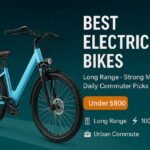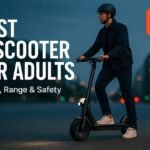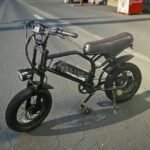Top 10 Best Sellers Electric Bikes on Amazon. Most Popular E-Bikes Based on Sales. Updated Frequently.
Buying Guide
The 60-Second Shortlist (how to decide fast)
- Commuters (flat terrain): Class 2 hub-drive, 500–750W, cadence sensor, 48V ~14–17Ah battery, fenders + racks included, hydraulic or well-tuned mechanical disc brakes.
- Hilly areas / heavier riders: 750–1000W hub with high torque (≥70Nm) or a mid-drive; torque sensor preferred; 48–52V with ≥17–20Ah battery.
- Comfort & errands: Step-through frame, swept-back bars, wide saddle, 2.1–2.6″ tires, rear rack rated ≥55 lb.
- Trail & mixed use: Fat tires (3–4″), lockout suspension fork, hydraulic discs, metal fenders or no fenders.
- Apartments & car-trunk life: Folding frame under ~65 lb, removable battery, magnetic frame clasp, smaller 20–22″ tires.
Step-by-Step: What Actually Matters
1) Legal Class & Speed (start here)
- Class 1: Pedal assist only, up to 20 mph—allowed on most bike paths.
- Class 2: Pedal assist and throttle, up to 20 mph—popular for commuting and casual riders.
- Class 3: Pedal assist to 28 mph (often throttle limited to 20 mph). Faster, but may face local restrictions.
Tip: If a model can be “unlocked,” make sure your local rules—and your riding environment—support it.
2) Motor Type, Power & Hill Performance
- Hub-drive (most Amazon best sellers): Simple, affordable, low maintenance. Great for flats to moderate hills.
- Mid-drive (fewer on Amazon): Uses your gears for leverage—best for steep hills and spirited riding, but pricier and more maintenance-sensitive.
- Power vs. torque: Watts describe peak output; torque (Nm) describes “push off the line.” For hills, prioritize higher torque and a torque sensor if available.
- Real-world rule of thumb:
- Flats / light hills: 500–750W hub is fine.
- Steep hills / heavier loads: 750–1000W hub or mid-drive with 60–90Nm+.
3) Battery & Real Range (don’t guess—estimate)
- Capacity matters: Use Watt-hours (Wh) = Voltage × Amp-hours.
- Example: 48V × 15Ah = 720Wh.
- Quick range math: Typical consumption is 10–20 Wh/mile.
- 720Wh ≈ 36–72 miles depending on rider weight, wind, terrain, tire pressure, and PAS level.
- Charging time: Most stock chargers are 2–3A. A 720Wh pack on 2A can take ~6–7 hours.
- Batteries you’ll live with: Lockable, removable, uses known cell brands, and has a solid BMS (battery management system).
4) Fit, Frame Style & Comfort
- Step-through = easy on/off, great for urban stop-and-go and riders with limited mobility.
- Geometry: Look for stack (upright comfort) vs. reach (sporty stretch). Adjustable stems are handy.
- Tires:
- 2.0–2.4″ = zippy city tires.
- 2.6–3.0″ = comfort + mixed terrain.
- 4.0″ fat = sand/snow/rough paths; heavier and can feel “floaty” at speed.
- Suspension:
- Lockout fork helps on pavement.
- Rear suspension adds comfort but also weight and complexity.
- Sizing: Check the maker’s rider-height range and standover. When in doubt, prioritize safer standover and a shorter reach.
5) Brakes & Safety Hardware
- Hydraulic discs deliver stronger, lighter-feel braking—worth it on any bike over ~60 lb.
- Rotors: 180mm (front) is ideal for heavier e-bikes.
- Lights: Hard-wired lights with daytime running mode improve visibility.
- Tires: Puncture-resistant casing and reflective sidewalls are underrated safety features.
6) Payload, Racks & Towing
- Total payload (rider + cargo) should exceed your needs by 15–20%.
- Rear rack rating matters if you’ll carry panniers, a child seat, or a basket.
- Trailers: Check for a standard axle/nut for hitch compatibility.
7) Drivetrain & Sensors
- Cadence sensor: Engages assist when the cranks turn—common and fine for casual rides.
- Torque sensor: Feels natural, smoother starts, better range efficiency—ideal if your route varies or you like “analog-bike” feel.
- Gearing: A wide-range cassette (e.g., 11–32/34T) helps keep cadence comfortable at 20–28 mph.
8) Display, Controls & App Features
- Clean bar layout, tactile buttons, and a walk-assist mode help daily use.
- App integration can add route tracking, over-the-air tweaks, or immobilizer locks. Don’t overpay for features you won’t use.
9) Support, Warranty & Parts
- Prefer models sold by the brand’s official Amazon store (easier parts/warranty).
- Look for 1–2 years on the electrical system and an accessible parts catalog (brake pads, derailleur hangers, displays, controllers).
- Skim Amazon Q&A and recent reviews for customer-service patterns.
10) Assembly, Weight & Storage
- Expect some assembly (front wheel, bars, pedals, accessories).
- E-bikes often weigh 60–80 lb—mind your car rack’s rating and apartment stairs.
- If storing indoors, pick a model with a removable battery and clean cabling.
Amazon-Specific Buying Checks (before you click “Buy”)
- Sold by / Ships from: Prefer “Ships from Amazon” and brand official store as the seller.
- Model version: Confirexact spec (battery size, brake type, sensor type) matches the bullets—listings sometimes mix trims.
- Spare battery price & availability: If you’ll commute daily, this matters.
- Return logistics: E-bikes are heavy. Check return window and who pays freight if something’s wrong.
- Serial number & photos: Record them on delivery; photograph the box in case of shipping damage claims.
- UL listings: Some buildings or cities require UL-listed systems (e.g., UL 2849 for the system, UL 2271 for the battery). If relevant to you, confirm this in the description or with the seller.
- IP rating: If you’ll ride in rain, look for IPX4+; still, avoid pressure-washing and never submerge components.
Smart Range Planning (plug-and-play copy)
- Conservative range estimate:
- Light assist & flats: ~10 Wh/mile
- Mixed terrain / normal use: ~15 Wh/mile
- Hills, heavy rider, high assist: ~20 Wh/mile
Example: 48V × 17.5Ah = 840Wh → ~42 miles at 20 Wh/mile (hard use) to ~84 miles at 10 Wh/mile (easy use).
Basic Maintenance Schedule (set expectations)
- After 50–100 miles: Check spoke tension, re-index gears, bed-in brakes, re-torque critical bolts.
- Every 300–500 miles: Inspect brake pads/rotors, chain stretch, tire wear & sealant, check battery mount hardware.
- Every 6–12 months: Replace chain (or sooner if stretched), refresh brake fluid (hydraulic), firmware updates if applicable.
Battery Safety & Care (high-value trust builder)
- Charge on a non-flammable surface in a ventilated area; avoid overnight charging when unattended.
- Use the included charger; do not mix chargers across brands.
- Keep the battery between 20–80% for routine use; store around 50–60% if unused for >1 month.
- Avoid extreme temps (<32°F / >95°F).
- If the pack is damaged, swollen, or smells odd, stop using it immediately and contact the seller.
Frequently Asked Questions (FAQ)
1) Which e-bike class should I buy?
If you want simplicity and broad path access, Class 1 is safest. Prefer a throttle? Class 2. Need faster commuting? Class 3 (28 mph PAS) where legal.
2) Is 750W enough?
For most riders on rolling terrain, yes. Heavier riders, cargo, or steep hills may benefit from 750–1000W or a mid-drive with strong torque.
3) How fast does a 750W e-bike go?
Most best sellers cap at 20 mph (Class 2) or 28 mph (Class 3 PAS). Actual top speed depends on gearing, tire size, rider posture, and firmware limits.
4) What’s the real range I can expect?
Use Wh ÷ (10–20 Wh/mile). A 720Wh battery is roughly 36–72 miles depending on assist level, hills, wind, and rider + cargo weight.
5) Hub motor or mid-drive—which is better?
Hub: lower cost, low maintenance, great for flats. Mid-drive: better climbing and efficiency, costs more and uses the drivetrain harder.
6) Cadence vs. torque sensor—why should I care?
Cadence sensors turn on when you pedal—fine for casual rides. Torque sensors scale power to your effort—more natural feel, usually better range.
7) Are hydraulic brakes worth it?
Yes, especially on 60–80 lb e-bikes. They offer stronger, more consistent stopping with less hand fatigue.
8) Can I ride in the rain?
Light to moderate rain is usually fine if the bike lists IPX4+. Dry the bike after rides, avoid power-washing, and keep connectors clean.
9) Do I need suspension?
A lockout front fork smooths rough pavement and paths. Full suspension adds comfort off-road but increases cost and weight.
10) What tire width is best?
- 2.0–2.4″: efficient city/commute.
- 2.6–3.0″: comfort and mixed paths.
- 4.0″ fat: sand, snow, and gravel stability—heavier and slower on asphalt.
11) How long do e-bike batteries last?
Typically 500–800+ charge cycles before noticeable capacity drop, depending on cell quality and care. Good habits (don’t overheat, don’t store fully charged) extend life.
12) Can I upgrade to a bigger battery later?
Sometimes. It must match your system voltage, mount, BMS, and controller limits. Check with the brand for approved packs.
13) What’s a safe way to charge?
Use the OEM charger, on a hard, non-flammable surface. Unplug after it reaches 100%. Don’t charge if the pack is very hot or very cold.
14) Will a folding e-bike fit in a sedan trunk?
Many 20–22″ folding models do, but measure your trunk opening and the bike’s folded dimensions. Consider the weight for lifting.
15) How do I prevent theft?
Use a quality U-lock + cable (or chain) through the frame and wheel, park in visible areas, remove the battery/display, and record your serial number.
16) Do I need to assemble the bike?
Usually some final steps: bars, front wheel, pedals, accessories. If you’re not comfortable, a mobile bike service or local shop can do a safety tune.
17) What about carrying kids or heavy cargo?
Check payload and rear-rack ratings. For child seats, verify compatibility with the rack standard and total weight limits.
18) Are Amazon e-bikes reliable?
Many are—especially those sold by established brands’ official stores with clear parts support. Read recent reviews, look for documented warranty help, and ensure spares are available.
19) Do I need a special car rack?
Yes—use a rack rated for e-bikes (higher weight per bike), ideally platform-style. Remove the battery before transport.
20) Are there any certifications I should look for?
If required by your building or local rules, look for UL-listed systems (e.g., UL 2849, UL 2271 battery). When in doubt, ask the seller to confirm the exact listing.
21) Can I ride on multi-use paths or mountain-bike trails?
Rules vary by city and land manager. Confirm your local regulations and trail signage—Class 1 is the most widely accepted.
22) My brakes squeal—normal?
Often new pads/rotors need bed-in: several firm stops from moderate speed. Keep rotors oil-free; if noisy persists, check alignment or glazing.
23) What regular maintenance should I expect?
Clean/lube the chain, check tire pressure weekly, inspect bolts monthly, replace brake pads and chains as they wear, and service hydraulics annually.
24) Can I charge at work safely?
If allowed, yes—use the OEM charger on a hard surface, don’t block exits, and don’t daisy-chain power strips.




